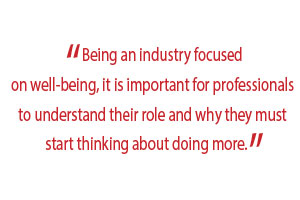A STATE OF CRISES
Type 2 diabetes continues to rise and often finds its beginnings in a person's decision to be inactive and make poor food choices. The American Diabetes Association  indicates that people spend over $250 billion to manage this preventable disease.
indicates that people spend over $250 billion to manage this preventable disease.
Obesity levels continue to rise and many of the causes of other diseases are rooted within the extra weight people are carrying. Two out of three adults are considered to be overweight or obese according to the National Institute of Health.
Depression is a silent stalker and the rate of diagnosis is escalating by about 20 percent every year. It is estimated that 80 percent of those affected by depression do not receive treatment. Depression is correlated with other negative health outcomes, such as obesity, heart disease, and stroke.
Managing these three conditions is costing the United States billions of dollars every year and adding extreme pressure to an already burdened health care system.
Fortunately, research continually validates the efficacy of spa services and clearly indicates how treatments such as massage can directly impact these top health concerns. The nation's well-being team of massage therapists and skin care professionals is quite large and, with such strong numbers, there is power in what they are able to accomplish.
WELLNESS GROWTH
Regardless of their role and type of facility, professionals do not have to look far to begin incorporating more strategic plans to offer wellness; people are already moving in this direction. The Global Wellness Institute revealed that the global wellness market is now worth $3.4 trillion, making it nearly three times larger than the $1 trillion worldwide pharmaceutical industry.1 Wellness tourism is expected to grow to a more than $675 billion market by 2017.2 Furthermore, The National Health Statistics Report reveals Americans spend up to $34 billion per year on complementary alternative medicine.3

Regardless of whether the professional is a sole practitioner in a private practice or leading a team of 100 experts, there are things the professional can do that will not only make a difference, but will also garner them a boost in profits as they tap into this consumer movement.
Professionals are encouraged to think outside the box and allow their creativity to blossom as they set intentions to do more and make a bigger difference. It takes courage to step outside of a comfort zone and risk failure, but when professionals succeed and their intentions are good, the reward is sweet.
First and foremost, in order to move strongly into the direction of wellness, there has to be a trailblazer within the business. A trailblazer is someone who holds a steadfast belief that things need to be improved and will not give up when they hit obstacles. Too many times, spa directors or professionals have great ideas, but are shut down before they have a chance to get started. Overall, there is a resistance to change and trying unproven tactics.
There are certain aspects of a spa or wellness experience that offer an opportunity to consciously impact someone's well-being. It is important to become aware of all the touch points that exist within the professional's experience that have an opportunity to become healthier. For example, does the professional have a cleaning service that comes in every evening and uses cleaners loaded with artificial scents and chemicals? Are there loud noises that impact the massage services? Does the spa offer candy as a snack? These little factors often create the opposite of what the professionals hope to offer clients.
Case Study: The Westin has developed well-being global initiatives to help clients feel their best. They have launched specific tactics to bring more wellness to corporate groups with their clutter-free meeting space, nutritional snacks for meeting breaks, and over-sized white boards. They have developed six pillars of well-being: sleep well, eat well, move well, feel well, work well, and play well."
TACTICS TO EXPAND WELLNESS FOR CLIENTS
Food
With food sensitivities on the rise and an American diet that is filled with preservatives, artificial ingredients, and unhealthy ingredients, it is no wonder that society is becoming more obese. The good news is that professionals have the ability to impact their clients' experience with food when they are at the spa.
There are some basic philosophies to adhere to as professionals contemplate what is healthy and what is not. The closer a food item is to its natural source, the
better; fresh fruits and vegetables are preferred over sugar-loaded health bars.
Professionals should become experts at label reading. If they cannot pronounce an ingredient, they probably should not offer it. Scan every aspect of the food that is offered to employees and clients and, if needed, transition to at least half of what is offered being more health conscious. A professional's food mantra should include low sugar, healthy fats, fewer ingredients, and whole foods. Be sure to maximize fresh fruits and vegetables, seeds, dried fruits, whole grains, and other organic choices and minimize chips, soda, candy, cookies, and other processed foods and beverages.
Case Study: Four Points Sheraton in Bentonville, Arkansas, which sees a lot of business from Wal-Mart's corporate headquarters, has created a special nutritious grab-and-go breakfast menu. They are doing their part to ensure corporate employees have the opportunity to start their day with better fuel.
Fitness
Whatever professionals can do to encourage movement can go a long way to inspire clients to be more health conscious. The professional's spa does not have to be in a five-star resort to begin integrating aspects of movement and fitness into their experience. Consider starting a walking group, offering outside classes, or creating a client contest based on wellness goals. People love to be engaged in a community of like-minded people who are focused on similar goals. If professionals have empty rooms during the day, consider offering a meditation class, simple stretching techniques, or free educational sessions with community partners.
Case Study: Marriott Marco Island got creative and began offering virtual fitness for guests. While instructor-led classes are more popular, this inventive decision allows them to offer a full day of classes to fit everyone's schedule. Even if only one person shows up, they accommodate these classes at little cost. The staff also discovered that they can create fun family activities, like virtual Bollywood dance lessons, for parents and kids.
Community Co-Op
There are, more than likely, many health and well-being practitioners in the area with whom clients can forge meaningful relationships. If the spa is small and there is not enough space or resources to hire practitioners, the professional can still create programs and access services through the creation of a co-op. Most independent health and wellness practitioners would love to have the opportunity to tap into the professional's client base to offer their services. In turn, the professional has the benefit of accessing the practitioner's clients and creating special programs.
Fun Events
If professionals have any amount of space, they have the opportunity to create fun events that include a wellness aspect. They can host healthy happy hours, schedule lectures on skin care, offer makeup tutorials, teach self-care with massage, or set up question-and-answer sessions with community experts. If the professional does not have adequate space, they should consider partnering with non-competing organizations to bring their expertise to their clients.
Case Study: Beautiful Inside and Out by Journey into Wellbeing was a partnership forged with Wild Thyme Healthy Cooking, The Spa at Marriott Griffin Gate and Sparitual vegan nail care line. The event was hosted at the cooking school and the chef offered a healthy cooking class, the spa offered a mineral makeup tutorial, and Sparitual nail polish changes were provided for every attendee. Each partner did their part to promote the event and compensation was provided through event proceeds.
Non-Traditional Spaces
There is a whole world of potential partners outside a spa's four walls that would love to partner with other professionals in some capacity. Look around and see what partnerships can be forged to bring aesthetic services to the community in a different way. For example, corporate offices may be interested in chair massage and polish changes; hotel executives might be interested in yoga classes or in-room massage; wellness expositions might hire professionals to do attendee services and lectures; bridal parties might want in-home services.
Case Study: The Massage Center, a renowned massage clinic in Lexington, Kentucky, expanded their offerings and began offering yoga classes to their clients and the community within an expanded space. In another effort to further their reach, they forged a partnership with a local hotel to teach yoga classes within a beautiful art-infused space. This offering has been their most popular class and they are seeing non-traditional attendees, such as college students, in the class.
Membership Programs
Building an enticing membership program can not only be beneficial for the professional's bottom line, but can also go a long way in encouraging members to stay active with their well-being goals. The key to success in building great membership programs is to have the right program that fits the spa's clientele. Ensure the spa's team is clear on their role in the sales process and that they consistently deliver on their part.
Case Study: Altitude Laser Spa, which is in Canada, has perfected a great membership program. Some keys to their success have been to create services only clients can access, create appealing employee incentives for membership conversions, and ensure every client is offered the membership consistently.
These ideas are just a few ways in which professionals can expand into the realm of well-being. Regardless of the professional's specific role within the spa, the first and most important step is to become clear in wanting to embrace wellness in a bigger way. Once professionals set this intention, there are limitless ways in which they can move forward. Often, they can start small and just do one thing, such as provide all clients with educational information. That offering can lead to classes, which can lead to memberships, and then to group activities. Regardless of what the professional tries, they can feel good that they are trying to do something more and making an impact on the nation's health.
References
1 Global Wellness Institute. (2014, September 30). Global Wellness Market is Now Three Times Larger than Worldwide Pharmaceutical Industry.
2 Room Key PMS. (2015, September 3). Health and Wellness Trends in the Hospitality Industry.
3 National Center for Complementary and Integrative Health. (2012). Statistics From the National Health Interview Survey.

Debra Koerner is on a mission to inspire our nation's health transformation. As the host of award-winning television show, "The Journey into Wellbeing," which airs on PBS, Koerner uncovers the secrets to living a high-energy, vibrant life. Her new show on healthy aging, "Senior Moments" can be viewed via her website, journeyintowellbeing.com. Koerner has worked with some of the top spas in the country and has served as the executive director for the Destination Spa Group. She co-owns a massage education and consulting firm, imassage, Inc., as well as Well World Productions. Over the years, she has become a popular keynote speaker and has been published in major publications, like Huffington Post, Woman's Day, and Newsweek.
